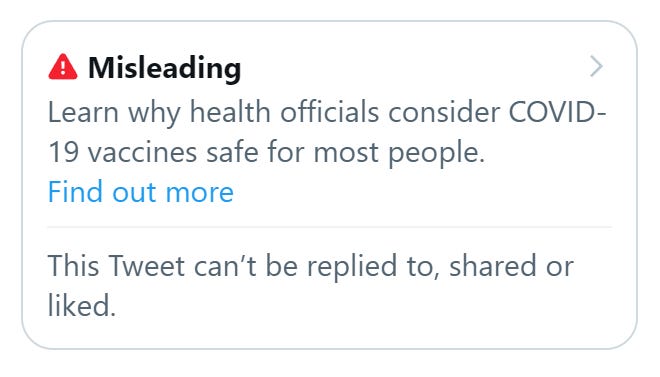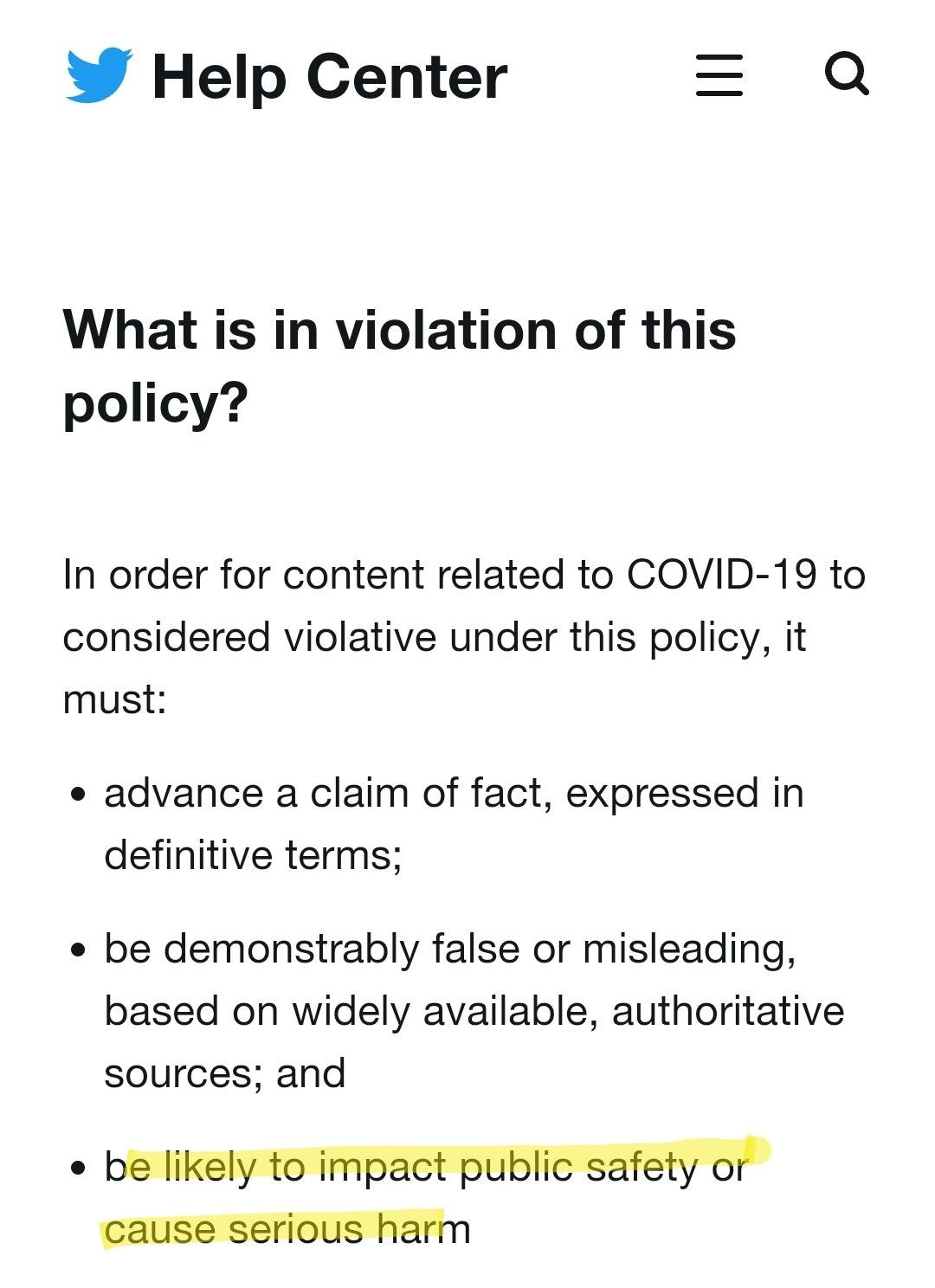See Part I of my response to the Covid Twitter Files — My Boxing Day Surprise.
My “Misleading” Tweet
On December 26,
published the Covid Twitter Files (the first edition of them at least?), and I was one of the Twitter users included in the release.My tweet on August 11, 2022 about causes of death in children was marked as misleading after apparently being identified by a bot and then targeted reporting by ZeroCovid activists, which we now know are called “tattles” in the Twitter backend. The original tweet is below, and you can expand the graphic to read the query results that I shared.

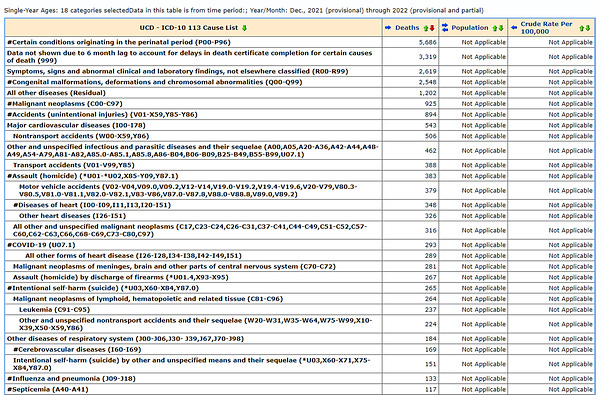
My tweet was a reply to a claim that “Since December of 2021 COVID has been the leading cause of death from disease in children.” I didn’t want to debate the semantics of whether Covid was the leading cause of disease, which hinges primarily on how you treat cancer (malignant neoplasms) and heart disease (diseases of the heart), which both caused more pediatric deaths than Covid. I will note that the CDC considers them rankable causes of death (that’s what the # in the screenshot above means), and that even CDC Director Walensky has only claimed that Covid was the leading infectious cause of death in children. She used that qualifier for a reason.
I simply pointed out that the prior claim was an attempt to maximize pediatric Covid deaths by choosing a narrow period of time, ignoring non-disease deaths, and excluding cancer or heart disease. Then I shared a screenshot of query results from the CDC WONDER database showing causes of death for children 0-17 from Dec. 2021 through the current month at the time. This should not have been controversial. And it did not in any way mention Covid vaccination. So imagine my shock when it was slapped with a warning saying “Misleading: Learn why health officials consider COVID-19 vaccines safe for most people.”
I also got an email saying my account was locked for “violating the policy on spreading misleading and potentially harmful information related to COVID-19.” The only information I spread was that many things had killed more children than Covid, which is a verifiably true fact using data that comes directly from CDC death certificates. This is the exact same data that actuaries and other experts have used to rank causes of death since well before Covid.
NOTE: Although the email stated my account was locked, I never noticed my account being locked, and I wasn’t required to delete the tweet. But the label still means that it can’t be replied to, shared, or liked. It also means that I’m now considered someone with a “recent violation,” so I am ineligible to join Twitter’s Community Notes program (formerly Birdwatch), which allows users to add helpful context to inaccurate tweets. (I’ve been told by Twitter that “recent” means anytime in the past 12 months.) Also, to be clear, this is the only Twitter violation I’ve ever been notified about, which is partly why I was so surprised. I’ve also never actually been suspended from Twitter, unlike many of my Twitter friends. Part of what makes my “violation” interesting is the response I got from Twitter.
Twitter’s “Fear Over Facts” Policy
I was confident that my tweet was not, in fact, misleading in any way, so I appealed to Twitter. As David Zweig included in his thread, that’s when Twitter Support explicitly told me via email that they “prioritize review and labeling of content that could lead to increased exposure or transmission.” I shared their response in my own tweet on August 11, right after I received it. I already essentially knew this was their policy, but seeing them admit it that explicitly to me in writing was surprising.

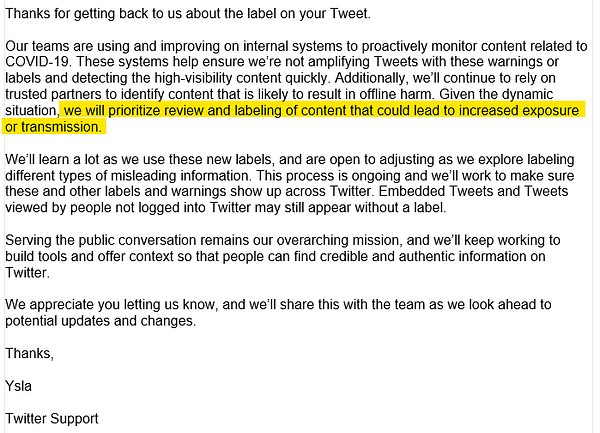
I had pointed out many times before that Twitter only considers something misinformation if it’s seen as minimizing, and that they had no interest in policing tweets that overstated Covid risks. Just a few days prior, I actually shared a link to Twitter’s Covid misinformation policy in a reply to David Zweig about a different tweet from another Twitter user with the same claim that Covid was the leading cause of death by disease in children.

This biased policy is why constant purveyors of Covid misinformation from ZeroCovid extremists were rarely, if ever, flagged for violating Twitter rules around Covid misinformation. Twitter had an ideological bent toward ZeroCovid, so tweets that caused more fear were allowed regardless of accuracy, while tweets that sought to assure people with valid data were potential violations. It’s also why Twitter curated “Covid-19 experts” that included people like Eric Feigl-Ding, Gregg Gonzales, Peter Hotez, Laurie Garrett, and Tom Frieden — while limiting the reach of people like Martin Kulldorff and Jay Bhattacharya.
As my Twitter friend Newman Nahas said, “Wrong info in the right direction was amplified.”


Twitter’s preference for fear-based Covid messaging is why I found the tweet below from the Covid Twitter Files so interesting. Jim Baker seemed to think that Trump just saying “Don’t be afraid of Covid” must somehow violate Twitter policies. Yoel Roth was shockingly the voice of reason that time, explaining that while optimistic, the tweet didn’t incite people to do anything dangerous or recommend against taking precautions like not following mask guidance, so it wasn’t an actual violation. (Of course, my flagged tweet didn’t recommend any particular dangerous or unsafe actions regarding Covid either. It seems these violations were more frequently applied when the account wasn’t a high-profile one like the President.)

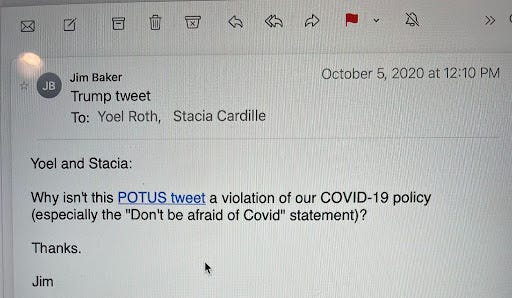
In 2020, I put #factsoverfear in my Twitter bio, because I thought it was an important summary of my approach to responding to Covid. I was anxious at first, but looking at the data was reassuring to me. At the same time, many others sought to exacerbate people’s fear and anxiety as much as possible, because they saw it as an effective way to encourage virus avoiding behavior. Of course this has had terrible longer term consequences for Americans when it came to school reopening, mental health, substance abuse, and more. Citizens, politicians, judges have all made decisions based on bad data because public health, mainstream media, and social media prioritized scaring people over accurately informing them. Fear and anxiety shouldn’t be a part of public health or government policy, but that’s been the hallmark of America’s Covid response in many ways, both on and off Twitter.



